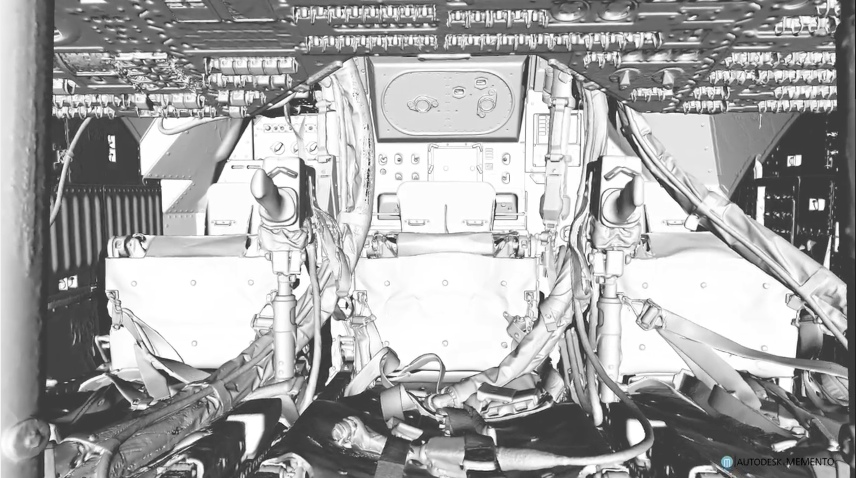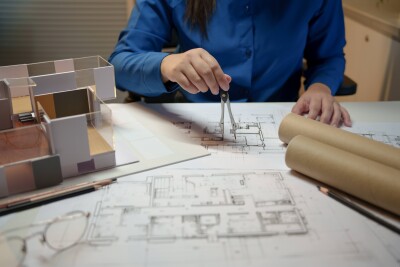A preliminary scan of the Apollo 11 command module
Autodesk has helped the Smithsonian to digitize the Cosmic Buddha, produced a digital life mask of President Obama, 3D scan the Wright brothers’ first working airplane, and even built the 3D.si.edu website where many of the Smithsonian’s 3D models are made available to the public. But none of this prepared them for the challenge of scanning the Apollo 11 Command Module Columbia.
A little background
The Smithsonian is in the process of remodeling the Air and Space Museum, where Apollo 11 is kept. Remodeling meant they had to move the command module, and moving it meant taking it out of the thick plastic case where it has rested since the museum was built in the ‘70s. This gave the museum a rare, “once-in-a-lifetime” opportunity to scan their crown jewel, the inside of which no one has seen for nearly five decades.
“So they took it out and we got the call,” said Brian Mathews, VP Technology and Architecture, Product Development Group at Autodesk. “They said, Hey, we’re only given so many days of access time with this. It’s probably one of the most challenging objects ever scanned, and we need some help.”
The project took two sessions to complete, the second one lasting eight days for a team of four employees from the Smithsonian and four from Autodesk. “There isn’t an object in a museum that has been scanned at this density, with this number of technologies,” said Mathews. “We threw the book at this thing.”

(Photo source: Washington Post)
An array of hardware
Autodesk and the Smithsonian used seven different scanning technologies on the command module.
This included two different types of high-precision terrestrial laser scanners, both of which were mounted on booms to keep the hardware from touching the command module. “Some [terrestrial scanners]are only good for short throw and are highly detailed,” Mathews said, “and some are better for longer throw. So we needed a combo.”
The team also used two different structured-light scanners. “These tend to be smaller, and can fit into crevices and such. They handle reflective surfaces a little bit differently than lasers do. So we used two different technologies in this camp.”
Lastly, they used two separate photogrammetry rigs designed specifically for this scan project, as well as a laser-line scan arm to capture certain parts of the exterior.
Scanning challenges
Why did they need to use all of these technologies? The sheer complexity of the command module’s interior.
First, the inside of the command module includes a lot of reflective metal. Even worse, the windows are covered in “weird” coatings that Mathews says “make the lasers go crazy.” A scanning team might cover glass like this in a normal project, but in this case they aren’t allowed to touch any part of the object they’re scanning.
The solution was to deploy the structured light scanners and the photogrammetry rig (complete with polarizers), both of which handled the reflective surfaces differently. This ensured that they had good data for every surface–when it couldn’t be captured by one technology, it was captured by another.

Apollo 11 LiDAR scan with gaps
Next, nearly every part of the module is hidden by some other part. “My god,” Mathews said, “the occlusions in this thing are just incredible. It’s so tight and there’s so much stuffed in there. Think of every little switch. Each one has a cover that is a little wire loop. Think of paperclip loops of metal—really thin, really shiny, and they’re covering up all the detail.”
In this case, the terrestrial scanners couldn’t be trusted for complete coverage, so the structured light scanners were deployed for capturing crevices where the larger scanner couldn’t fit.
“Generally,” Mathews said, “there is one that’s going to give you the best data for a particular surface condition—the range you’re at, the surface type you have, its properties and so on.”
With some ingenuity, and a plan to fuse the data later into a final model, the team was able to produce “really stellar results.”
More data, more problems
Using all of these different technologies solved a number of problems—but then created a few more.

For one, the custom hardware they built for this project generated data that was difficult for existing software to handle. “This data was higher resolution than what most commercial software has even seen,” said Mathews. “We tried our competitors’ software, we tried our software, and at first nobody’s software worked. So we went into our own and had to tweak some of the algorithms to work with this extra precision.”
With their Memento software updated, there was still the challenge of registering data coming from seven different sensors. “We wanted this thing to be super tight,” Mathews explained. “When you have seven different types of scanners coming together, each of them has its own drift properties or other properties. Getting all of these jigsaw puzzle pieces to fit together really accurately was a challenge, and we had to change some of our algorithms to make it do that.”
With their new proprietary software complete, Autodesk is working to process the data into a photorealistic mesh model. By the time Autodesk has completed the processing, Mathews estimates the model will include more than 1 billion triangles.
The end game
Of course, the final goal of the project is more than just a good story or a huge model—it’s sharing the Apollo 11 Command Module with a new generation.
Autodesk and the Smithsonian hope to make the model available to the public for virtual reality exploration. The experience they are working on would allow the user to tour the module, and maybe even point to “hot spots,” or specific highlighted objects within the cabin to hear an explanation of their significance. This may mean hearing a history from someone who understands the object’s intricacies, like a curator from the Air and Space Museum, or it may mean hearing a story from one of the original NASA engineers who helped design it. You may also have the opportunity to download a copy of the model and 3D print it for your desk.
Whatever form it takes, it’s likely to be the only way you see inside the Apollo 11 command module. Look for it this summer.






